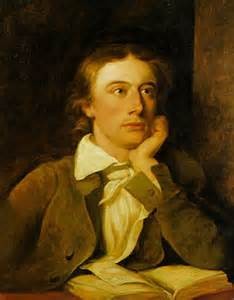Posted by Isabelle McAlevey
Four Seasons fill the measure of the year; There are four seasons in the mind of man: He has his lusty Spring, when fancy clear Takes in all beauty with an easy span: He has his Summer, when luxuriously Spring's honied cud of youthful thought he loves To ruminate, and by such dreaming high Is nearest unto heaven: quiet coves His soul has in its Autumn, when his wings He furleth close; contented so to look On mists in idleness—to let fair things Pass by unheeded as a threshold brook. He has his Winter too of pale misfeature, Or else he would forego his mortal nature.
 John Keats (1795-1821) was an English Romantic poet who contributed several great works to the canon of English-language poetry. Though Keats trained formally as a surgeon, his literary pursuits distinguished him as a tactful writer even in his own time. He often employed picturesque imagery that reflects his upbringing at a stable, as in this poem where the bucolic suggestions conjure images of the countryside.
John Keats (1795-1821) was an English Romantic poet who contributed several great works to the canon of English-language poetry. Though Keats trained formally as a surgeon, his literary pursuits distinguished him as a tactful writer even in his own time. He often employed picturesque imagery that reflects his upbringing at a stable, as in this poem where the bucolic suggestions conjure images of the countryside.
This poem presents the different stages of life rendered as the four seasons of the year. Instead of describing the physical nature of these stages however, they are the seasons present in “the mind of man.” For every “season” of life, man has a different outlook. First, he lives his “lusty spring” during which anything seems possible and he observes “all beauty.” The idea that in Spring man can take in all beauty with an “easy span” suggests a certain naiveté in youth where one thinks all beauty may be observed in singularity. Keats personifies Spring as “lusty” to emphasize the parallel between the season and the youthful state of mind. Spring occupies only two lines of this sonnet, which further reflects the brevity of a childish outlook on life.
Next comes his Summer, which lacks the same lust and ease of Spring, but during which he can “ruminate” on Spring’s “honied cud of youthful thought.” What were once youthful, fleeting thoughts can, in Summer, be reflected on with more clarity, and pondered or chewed over as a cow or ruminant animal would chew and re-chew its cud. This is no regular cud, however, but “honied” cud that retains the sweetness of youth and its wistful musings. During his Summer, by reflecting on his Spring, man gains a sense of enlightenment, or “dreaming high,” that is “nearest unto heaven.” While growing nearer to heaven, both in acquiring a sense of self and more literally aging towards a time of death, man enters the “quiet coves” of Autumn. These “quiet coves” contrast the image of man’s mind ruminating on his “honied cud” of youth. While the language Keats uses to illustrate Summer evokes exposure and clarity, Autumn suggests a resignation into one’s own thoughts and some emotional closure. Keats employs zoomorphism to portray man’s soul in Autumn as a bird that “furleth close” its “wings.” The image of a bird, unlike that of a cow, suggests an ability to transcend or harness powers of higher imagination. This aligns with the wiser years of later adulthood and the introspection it brings.
 Autumn receives the largest portion of the poem with four lines, accentuating the length of this mindset in man’s life. A time of contentedness, man may look on “mists in idleness,” seemingly at peace with what may not appear clearly, and resigning himself to look not only on beauty as the young man does, but also on what he cannot understand. “Fair things,” the ones man might have lusted after and enjoyed in his Spring, he allows to “pass by unheeded.” Man in his Autumn seems to be waiting, aware of his environment but no longer driven by its delights.
Autumn receives the largest portion of the poem with four lines, accentuating the length of this mindset in man’s life. A time of contentedness, man may look on “mists in idleness,” seemingly at peace with what may not appear clearly, and resigning himself to look not only on beauty as the young man does, but also on what he cannot understand. “Fair things,” the ones man might have lusted after and enjoyed in his Spring, he allows to “pass by unheeded.” Man in his Autumn seems to be waiting, aware of his environment but no longer driven by its delights.
Then, man has his Winter, which brings man’s “pale misfeature,” a phrase that can be read as death. The odd and ghostly pallor of death finalizes the natural process of living, and not to experience Winter would to be to “forego” man’s “mortal nature.” The slant rhyme between “misfeature” and “nature” creates a tone of inevitability in death, where it appears as a structural necessity, albeit a slightly uncomfortable one.
In this poem, man embraces every stage of life he finds himself in, and seems aware of that stage fully while never entirely acknowledging the next. Keats died at the age of twenty-five, and it is amazing that he was able to produce this kind of reflective work so young. By animating the seasons, Keats creates a vision of human life that mirrors natural processes, reinforcing the bond between humans and the environment. Furthermore, Keats paints a romantic vision of what it means to live, in a form that conveys a reverence for life’s sequence and structure.

